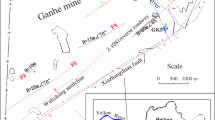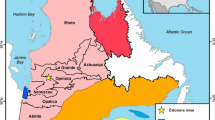Abstract
Geothermal water from a Cambrian limestone aquifer presented a flooding risk at the No. 8 coal 21 mine near Pingdingshan City, China. The water-bearing zones were identified using the mine transient electromagnetic method and direct current prospecting, and a groundwater drainage system was installed. After water drainage was implemented, the water level in the limestone near the haulway dropped 17.2 m in 277 days, greatly reducing the risk of a mine water inrush. The water quality, quantity, and temperature allowed it to be used for mineral baths, resulting in energy savings and emission reductions.
Zusammenfassung
Geothermale Wässer aus einem kambrischem Kalksteinaquifer bedrohten die Nr. 8 Kohlenmine nahe von Pingdingshan City, China, durch das Risiko eines Einbruches und Flutung. Die wasserführenden Zonen wurden mittels transienter elektromagnetischer Methoden (TEM) und Gleichstromerkundung (DC) bestimmt und ein Dränagesystem eingerichtet. Nach Fertigstellung der Dränage fiel der Wasserspiegel im Kalkstein neben der Förderstrecke 17,2 m in 277 Tagen, wodurch das Risiko eines Wassereinbruchs stark reduziert wurde. Qualität, Quantität und Temperatur des Wassers ermöglichten eine Nutzung für Mineralbäder, wodurch Energie gespart und Emissionen reduziert wurden.
Resumen
El agua geotermal de un acuífero Cambrian formado por calizas, presentaba un riesgo de inundación en la mina de carbón 21 cerca de la ciudad de Pingdingshan, China. Las zonas acuíferas fueron identificadas usando la prospección por el método electromagnético transiente (TEM) y corriente directa (DC); se instaló un sistema de drenaje del agua subterránea. Después de implementar el drenaje de agua, el nivel del agua en la caliza cerca de su recorrido descendió 17,2 m en 277 días, reduciendo significativamente el riesgo de irrupción de agua en la mina. Debido a su cantidad, calidad y temperatura, el agua pudo ser usada en baños minerales, lo que produjo ahorro de energía y reducción de las emisiones.
摘要
寒武系岩溶热水对平顶山矿区(中国河南)8号煤矿21煤层安全回采构成突水威胁。运用井下瞬变电磁(TEM)及直流电法(DC)勘探煤层下伏岩溶富水区,安装配套井下排水系统。经含水层疏水降压,井田大巷附近岩溶水位277天内下降17.2 m,大幅降低矿井突水危险。岩溶水水质、水量及水温特征使其宜作矿泉热水,将能节省能源,减少水资源浪费。







Similar content being viewed by others
References
Anandan KS, Sahay SN, Ramabadran TK, Shiv PS (2010) Groundwater control techniques for safe exploitation of the Neyveli lignite deposit, Cuddalore District, Tamil Nadu, India. Mine Water Environ 29(1):3–13
Chai R (2010) Selection of geothermometers and estimate of the temperature of geothermal reservoir in the Pingdingshan 8th mine. Coal Geol Explor 38(1):58–61
China Pingmei Shenma Group (2013) 2012–2015 planning for coal mine limestone water control of Pingmei Shenma Group (monograph). China University of Mining and Technology Press, Xuzhou
Geologic Exploration Standard of Geothermal Resources of China, GB11615-1989
Ghasemizadeh R, Hellweger F, Butscher C, Padilla I, Vesper D, Field M, Alshawabkeh A (2012) Groundwater flow and transport modeling of karst aquifers, with particular reference to the north coast limestone aquifer system of Puerto Rico. Hydrogeology 20(8):1441–1461
Han DP, Li D, Cheng JL, Wang P (2010) DC method of advanced detecting disastrous water-conducting ore water-bearing geological structures along same layer. J Chin Coal Soc 35(4):635–639
Hancock S, Wolkersdorfer C (2012) Renewed demands for mine water management. Mine Water Environ 31(2):147–158
He XW, Yang J, Shao LN, Li FQ, Wang X (2008) Problem and countermeasure of mine water resource regeneration in China. J Chin Coal Soc 33(1):63–66
He GJ, Ruan GQ, Yang Z (2011) Research and application on preventive measures against heat disaster in Zhaolou coal mine. J Chin Coal Soc 36(1):101–104
Henan Polytechnic University (2009) Floor geophysical exploration for the 21 coal seam in the west alley of no. 8 mine, Tian’an Coal Mining Co Ltd No. 8 Mine. Henan
Henan Polytechnic University (2010) Study on the optimal allocation of the comprehensive utilization of geothermal water in deep mining area, Tian’an Coal Mining Co Ltd No. 8 Mine. Institute of China Pingmei Shenma Group Research (report)
Henan Polytechnic University (2012) Tian’an Coal Mining Company Limited No. 8 Mine, Tian’an Coal Mining Company Limited Geological Survey Department. Research and implementation for geothermal water disaster control and utilization of No. 8 Mine (report), Henan, China
Jardón S, Ordóñez A, Álvarez R, Cienfuegos P, Loredo J (2013) Mine water for energy and water supply in the central coal basin of Asturias (Spain). Mine Water Environ 32(2):139–151
Singh AK, Mahato MK, Neogi B, Singh KK (2010) Quality assessment of mine water in the Raniganj coalfield area, India. Mine Water Environ 29(4):248–262
Standards for Drinking Water of China, GB5749-2006
Standards for Natural Mineral Water of China, GB8537-1995
State Administration of Work Safety (2009) State administration of coal mine safety, provisions for mine water prevention and control. China Coal Industry Publishing House, Beijing
Su L, Liu XM, Liu Y (2011) Application of prospecting water- rich area of coal with TEM. Chin J Eng Geophys 8(1):6–9
Sun W, Wu Q, Dong D, Jiao J (2012) Avoiding coal-water conflicts during the development of China’s large coal-producing regions. Mine Water Environ 31(1):74–78
Tan JQ, Ju YW, Hou QL, Zhang WY, Tan YJ (2009) Temperature field distribution and its affecting factors in Sulin mine area of Huaibei. Chin J Geophys 52(3):732–739
Wang XY, Li S, Xu GQ, Zhao YQ, Gao ZJ, Dong DL (2011) Special hydrogeology (monograph). China Univ of Mining and Technology Press, Xuzhou
Winters WR, Capo RC (2004) Ground water flow parameterization of an Appalachian coal mine complex. Ground Water 42(5):700–710
Yang W, Yang LL, An J, Zhang SG (2011) Numerical simulation and analysis of mine ventilation temperature field of integrated mining area in high temperature mine. Coal Geol Explor 39(5):55–58
Acknowledgments
This work was financially supported by the National Natural Science Foundation of China (Grant 41272250) and Henan Province’s Technological Innovation Team of Colleges and Universities (Grant 15IRTSTHN027).
Author information
Authors and Affiliations
Corresponding author
Electronic supplementary material
Below is the link to the electronic supplementary material.
Supplemental Fig. 1
Contour map of the geothermal gradient in the No. 8 mine (PDF 399 kb)
Supplemental Fig. 2
Profile map of apparent resistivity detected by the TEM vertical test (PDF 391 kb)
Supplemental Fig. 3
Profile map of apparent resistivity detected by the DC vertical test (PDF 391 kb)
Supplemental Fig. 4
Water transport and distribution system from the west alley to the ground (PDF 382 kb)
About this article
Cite this article
Wang, Q., Wang, X. & Hou, Q. Geothermal Water at a Coal Mine: From Risk to Resource. Mine Water Environ 35, 294–301 (2016). https://doi.org/10.1007/s10230-015-0352-6
Received:
Accepted:
Published:
Issue Date:
DOI: https://doi.org/10.1007/s10230-015-0352-6




